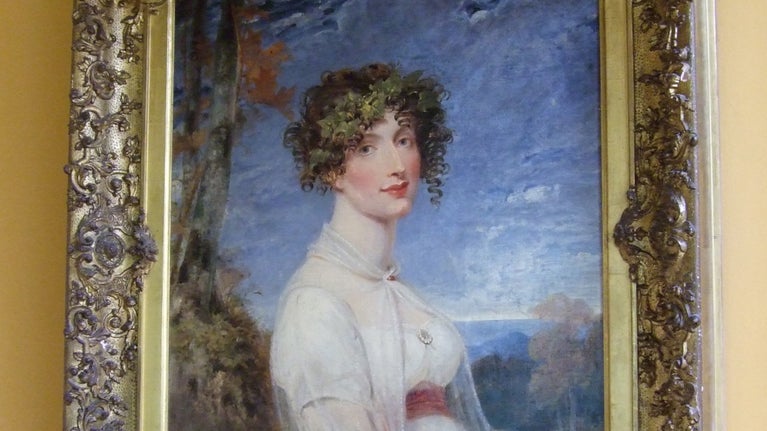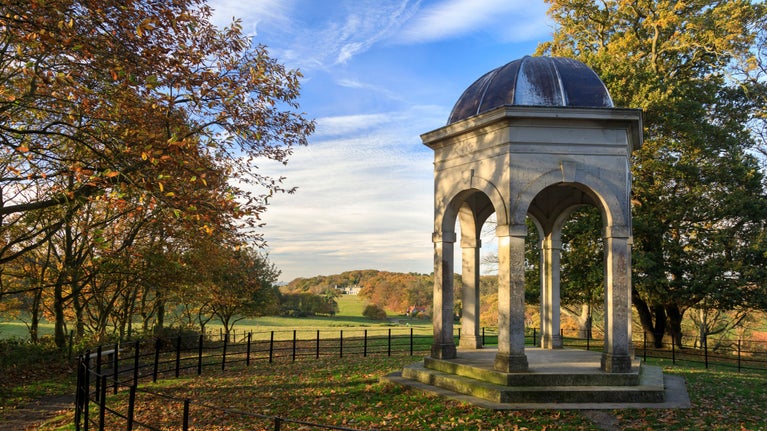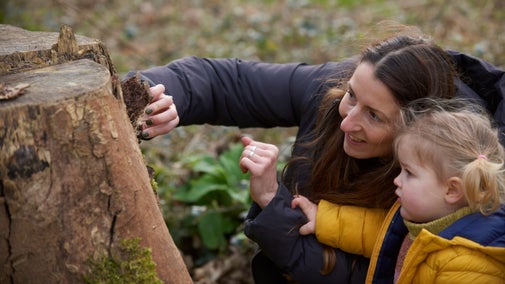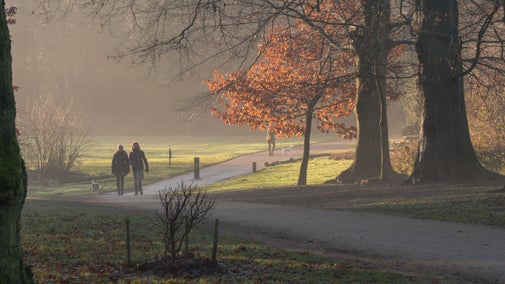
Visit Sheringham Park
Discover how to get to Sheringham Park, where to park, what there is to see and do, and more.

The Sheringham estate in Norfolk features one of England’s most significant designed landscapes, laid out by the eminent garden designer Humphry Repton. In the mid-19th century, Sheringham Hall was the home of Charlotte Upcher, an active campaigner for the abolition of slavery. Charlotte’s eldest son, Henry Ramey Upcher, completed work to the parkland and house, forming what is now one of the most significant collections of rhododendrons in the country.
Little is known about the site, which is now the designed landscape at Sheringham Park, before the 1700s, although archaeological excavations have revealed middle Bronze Age pottery, boundary banks and sunken roads. The Flower family owned the estate for most of the 18th century, with Cook Flower (d. 1743) – described as a ‘Gentleman of Sheringham’ – responsible for adding tree plantations to the existing older oak forest.
The well-established woodlands, convenient for shooting, and the attractive coastal position caught the attention of Abbot Upcher (1784–1819). Upcher was the son of a wealthy farmer who had recently married and was in search of a suitable estate for his family. He recorded his joy of the purchase in his diary, writing, ‘How did our hearts throb with gratitude to the Father of all mercies for at last giving us a place of our own’!
The Upchers viewed Sheringham as an ideal place to raise their young family, but also as an investment in land and agriculture. In purchasing the estate, they saw an opportunity to elevate their social status as well as to offer moral leadership to the rural community. After meeting Humphry Repton (1752–1818) at a dinner party in 1811, Upcher promptly commissioned the influential designer to come up with plans for his new estate.
‘My favourite and darling child in Norfolk’
– Repton writing of Sheringham in 1817
Humphry Repton was the last great designer of the classical phase of English landscape gardening. He is often regarded as the successor to Lancelot ‘Capability’ Brown, the most famous British gardener and landscape architect of the 18th century. Along with his architect son, John Adey Repton (1775–1860), Humphry Repton set about designing a new house and surrounding parkland for his young clients. By Repton’s own admission, Sheringham was his masterpiece and favourite work. At Sheringham, he was confident that Abbot Upcher would carefully follow through with his design.
Repton presented the design proposal in one of his famous Red Books, written in his own hand and illustrated with watercolour sketches. The Sheringham Red Book is considered to be one of his most comprehensive, and a mark of the affinity he felt with Upcher. It is now cared for by the National Trust and is kept at nearby Felbrigg Hall, Norfolk.

At Sheringham, Repton designed a new drive which ‘revealed’ a view of the Hall in the landscape. He carefully sculpted the drive out of the existing woods to offer the best views of the land, the sea and the Hall. It is only when the drive emerges at The Rookery, at a point known as ‘the Turn’, that the significance of the design of Sheringham is revealed: a perfect balance of aesthetic vision, social convenience and comfort of the client.
Repton proposed a new house to replace the existing old farmhouse, to be situated close to the village of Upper Sheringham. He recommended that it be of a relatively modest design with rooms ‘not extravagant in size or quantity’, and that visitors be permitted to enter the estate to enjoy the views. He also suggested that the Upcher family admit the rural poor to gather dead wood within the estate boundaries. The Upchers were committed to engaging with the community at a time when social relations were divisive across much of the country owing to unemployment, economic depression and a run of poor harvests.
Work to implement Repton’s design began in early 1813. The first stones of the new house were laid in July, with Repton and John Adey both present. By the end of 1816, the roof was completed. Abbot and Charlotte planned to move in during the summer of 1817. However, Abbot fell ill that year with a ‘brain fever’. He never recovered and died in 1819, age 35. Just a few months later, Repton also died.

Abbot's wife Charlotte did not move into the Hall, but she continued to manage the estate. She was an active member of the local community, campaigning for, and donating to, causes such as the town’s first lifeboats.
Charlotte was a strong supporter of the movement to abolish slavery, particularly through her friendship and support of the anti-slavery campaigner Thomas Fowell Buxton. In 1834 Charlotte held a fête at Sheringham Hall to celebrate the abolition of slavery in the British Empire, also penning a poem in her notebook dedicated to, ‘Poor Africa’s sons we are trying to raise, by the blessing of God, in these later days’. The Norfolk Record Office now holds the personal papers of Charlotte Upcher, which document her support for the movement.
It was not until Abbot and Charlotte’s eldest son Henry Ramey married in 1839 that the house was finally completed on a slightly more modest scale. Successive generations of the Upcher family continued to develop the estate, following Repton’s design as closely as possible. One of the last features to be built was the Temple, which was commissioned by Thomas Upcher (1906–85) and constructed in 1975 in a slightly different position to Repton’s original proposal.
Thomas Upcher was the last private owner and he did much to improve the diversity of the rhododendron collection.

Thomas Upcher had offered Sheringham to the National Trust in the 1970s, but it was not taken up. By the mid-1980s, however, the National Trust developed a deeper appreciation of the landscape history at Sheringham. In 1986 the National Trust acquired the Hall and an estate of 770 acres (of 1,250 acres total, not all of which was purchased at the time) from the family trustees, funded by bequests and grants from various sources.
In the late 1980s, the National Trust actively restored the park, cutting back rhododrenons and restoring the view from the Turn. In 1987 a gazebo was built near the site of a signal station in the wood to the north of the Hall. A car park kiosk was added in 1996, and visitor facilities were established in the outlying Wood Farm in 2004. The Hall is tenanted on a long leasehold, as it has been since the National Trust purchased the estate, and is only open to the public by written appointment.
R.W. Ketton-Cremer, A Norfolk Gallery, London, 1948.
Christopher Hussey, Country Life, 1957.
Jeremy Musson, ‘Sheringham Hall: How Repton created a “masterpiece in the synthesis of architecture and landscape”’, Country Life, January 2021.
Jeremy Musson, ‘The restoration of Sheringham House, Humphry Repton's “darling child” and “most favourite” work’, Country Life, February 2021.
Personal Papers of Charlotte Upcher, Norfolk Record Office (NRO: PC 235, 643X1).

Discover how to get to Sheringham Park, where to park, what there is to see and do, and more.
Plan a family day out with nearly 1,000 acres to explore. There’s plenty of space for kids to burn off some energy as you enjoy a variety of habitats that Sheringham Park has to offer.

There’s lots of nature and wildlife to spot at Sheringham Park. From woodpeckers to skylarks on the cliff tops to snakes basking in the wild garden, here’s some seasonal highlights.

Learn about people from the past, discover remarkable works of art and brush up on your knowledge of architecture and gardens.

From landscape gardeners to LGBTQ+ campaigners and suffragettes to famous writers, many people have had their impact on the places we care for. Discover their stories and the lasting legacies they’ve left behind.
